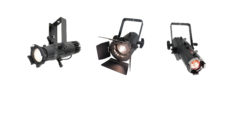
InFocus LP640
Jun 1, 2004 12:00 PM,
By Jeff Sauer
InFocus LP640
There is a lot of sex appeal in a projector’s ability to show motion-picture cinematography with deep blacks and jitter-free motion. But the majority of projectors spend most of their time showing bright, staid presentation slides and spreadsheets. That’s where most of the business is, so there’s still a huge market for conference room and classroom projectors, particularly at affordable levels. That’s the thinking behind the new LP640 from InFocus.On the surface, the LP640 is a no-frills, tabletop or ceilingmounted model with sufficient brightness and a typical LCD contrast ratio in a boxy, 7½-pound chassis. Its price of $2,499 isn’t bad at all for a native XGA projector that performs solidly. Still, InFocus isn’t only about utility. A closer look reveals a lot more to like about this seemingly modest presentation projector.ALL MODESTY ASIDEThe LP640 is a three-panel LCD projector with a micro lens array and a native 4:3, 1024-by-768 resolution. The chassis has a recessed lens housing, with manual focus and zoom rings accessible from a cutaway along the top of the unit and a throw ratio of 1.6:1 to 1.9:1.Connectivity is basic but not as minimal as you’d expect from a bare-bones projector. For example, the LP640 has InFocus’s common M1-DA connector that, through a proprietary cable, inputs analog RGB and USB mouse information into the projector’s remote. That M1-DA is also the port for digital DVI-D input, as well as component video, but both of those require an optional proprietary cable. However, this projector is unlike InFocus’s travel projectors, for which back-panel space is at a premium. InFocus smartly includes a 15-pin analog RGB computer input and a monitor out port, helpful in many classroom and presentation situations. There’s also composite video, S-video, and stereo RCA audio inputs for the 2W stereo speakers.InFocus has paid a lot of attention to usability and design during the past few years, and the LP640 reflects that. For example, a chime sounds when the projector is first powered up, and all 13 buttons on the unit’s top light up. There’s no wondering whether you’ve hit the button hard enough when this unit is powering up. What’s more, a small LCD on the top counts down both the wait before the lamp begins to shine and the cooldown period before power-down.The unit-top LCD also shows what input source is selected and which button you’re pushing. That’s rather less helpful. It might be more interesting for InFocus to offer help tips in that LCD, perhaps suggesting that a presenter consider adjusting keystone or color preset. There are projectors that include, for example, levels for automatic keystone correction as well as light meters for brightness and color temperature settings. Imagine a projector that is smart enough to teach users about those features. The LP640’s LCD is a good starting point, but on this more affordable unit, its functionality is rather limited.The LP640 does feature an automatic input detection mode that quickly scans through inputs to determine the source. This is a strength in terms of usability. Awkwardly, though, if no source is detected, you effectively have no way to view the menus because the searching function takes over.The LP640 is compatible with InFocus’s LiteShow wireless feature that allows you to connect and display images without a cable. LiteShow, an optional accessory, uses the M1-DA connector and requires just a standard 802.11b PC Card in your computer. There is typically a refresh delay of one to three seconds, especially when changing or opening entire new windows, but latency is almost undetectable for mouse movements and keyboard stokes. The LP640 also works with InFocus’s optional ProjectorNet software for remote monitoring.InFocus gives the LP640 a brightness rating of 2200 ANSI lumens. I measured 1940 lumens across the entire image, and that’s a differential of about 10 percent. At its brightest, I measured only 2073 lumens, but that’s about normal for the projector industry. I did measure a full on/off contrast ratio of 408:1, which is marginally higher than InFocus’s listed specification. That’s a good number for LCD-based units. More meaningfully, I also measured an ANSI checkerboard contrast ratio of 221:1, excellent for any projector.The LP640 is also fairly consistent across the entire image, with a brightness uniformity of 87 percent, by my calculations. It’s not quite as consistent as I’d like across the entire picture in terms of color temperature, with a 1,200 degrees Kelvin differential side to side. It does fairly well, however, with color temperature across a range of gray scales. The exception to that is a roughly 2,500 degrees Kelvin jump in color temperature when grays become dark. Although not ideal, those shortcomings affect motion video performance more than projection in presentation mode.The LP640 certainly isn’t a projector with any significant ability to handle video. Although it supports component video input, it does so only with a proprietary cable through the M1-DA input and not, as with so many projectors these days, through the 15-pin RGB port. What’s more, even with that custom InFocus component video cable, the LP640 can handle component video only with progressive-scan sources, not far more common interlaced sources. For interlaced video, you’ll have to use the S-video or composite inputs. These offer a bare minimum of quality: the range of the signal and the cable type are limited, and the deinterlacing is rudimentary and leaves plenty of video jitter.CHARMED, I’M SUREBut that just takes us back to the beginning. The LP640 isn’t trying to be a motion-video projector but, rather, an affordable, hard-working presentation projector that is destined for conference rooms and classrooms. At $2,499 the LP640 sits some $500 to $1,000 above the least expensive tier of today’s desktop units, and it’s also a step higher in quality and brightness. But it has a good price/performance value.And what of sex appeal? Well, there is certainly glory to be found in clear teaching, effective selling, and accurate communication of information. That’s where the LP640 really turns on the charm.PRODUCT SUMMARYCompany: InFocus, www.infocus.comProduct: LP640Pros: Automatic input detection mode. Excellent ANSI checkerboard contrast ratio.Cons: No significant ability to handle video.Applications: Presentation projector for classrooms and conference rooms.Price: $2,499SPECIFICATIONSBrightness 2200 ANSI lumensContrast 400:1 full on/offNative Resolution XGA (1024 × 768)Configuration 3 × 0.79″ TFT active matrix p-silicon LCD panelsLight Source 170W UHP lamp/rated 2,000 hoursLens Manual focus, manual zoom (1.2:1)Projection Distance 5.0-32.8 feetScreen Size 40-300 diagonal inchesKeystone ±25° vertical, ±15° horizontalSpeakers 2W stereoDimensions (H×W×D) 4.1 × 11.6 × 10.3 inchesWeight 7½ lb.









